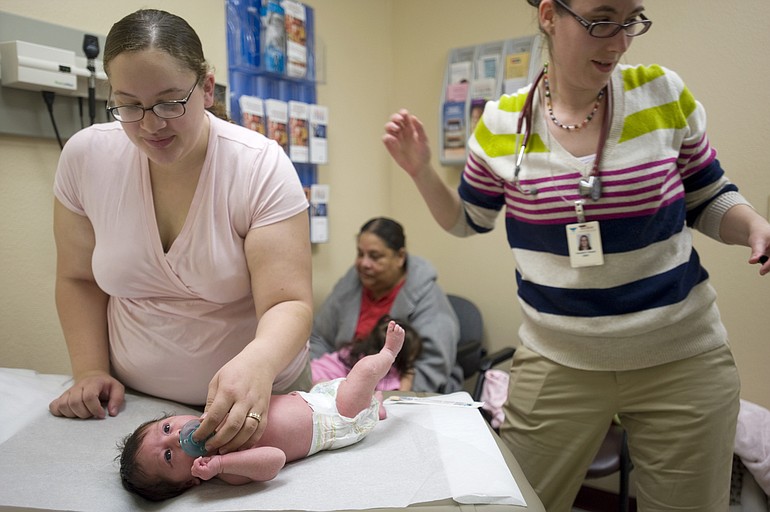When it comes to cuts in health care for the poor, Carrie Vanzant can talk numbers.
The director of Vancouver’s Sea Mar Community Clinic spent two days in Olympia earlier this month doing just that with 50 legislators who will help decide the fate of Washington’s Basic Health Plan and other programs over the coming weeks.
About 2,200 Clark County residents lost Basic Health coverage as a result of last year’s cuts. If the program for the working poor is eliminated, as it would be under Gov. Chris Gregoire’s all-cuts budget, another 4,500 county residents will lose coverage.
“For Clark County, we are the safety net,” Vanzant said. “We accept everyone. We have a sliding-scale fee.”
Vanzant can also tell you about Richard, one of her patients. He has epilepsy and Type 2 diabetes.
Last July, as the state was looking for ways to slash Medicaid spending for the poor, Richard got a letter from the Department of Social and Health Services informing him that “certain Medicaid services will now be limited or no longer available” beginning Aug. 1.
Those included the lancets and test strips diabetics need to test their blood sugar levels. Under the new rules, diabetics who were not on insulin would now be limited to 100 strips and lancets every three months.
In practical terms, that meant that instead of checking his blood sugar five times a day, a regimen essential to maintaining control of his diabetes, Richard would be able to check it only once daily.
In the past six months, Richard has been hospitalized four times for medical emergencies related to his diabetes and epilepsy.
“I saw him a month ago,” Vanzant said last week. “He looked like he had been hit by a bus.” His face was covered with dark bruises, the result of a grand mal seizure. And his diabetes was out of control.
“Richard has cost far more with his four hospital stays than the cost of those test strips,” she said.
Richard’s story is just one example of what Vanzant sees as a quiet crisis in the community’s ability to provide health care to the poor and uninsured.
Increased stress
Vancouver’s Sea Mar clinic is part of a Seattle-based network of 18 community health clinics along the Interstate 5 corridor. It has had a presence in Clark County for seven years, gradually expanding to fill a need for low-cost health care that two free clinics could not begin to meet.
Late last year, Sea Mar took over the Women, Infants and Children nutrition program from the Clark County Department of Public Health, which could no longer afford to run it. That program is located at the county’s Center for Community Health on Fourth Plain Boulevard, where Sea Mar now has a second clinic.
“The public health department is crippled,” Vanzant said. “We took on 10,400 clients overnight,” nearly doubling Sea Mar’s caseload to about 25,000.
The clinic also is beginning to absorb the cost of caring for patients who lost coverage under the Basic Health Plan when the state cut its caseload by 43,000 to help fill a $9 billion budget deficit last year.
Those people still need health care, Vanzant said.
“We still see these folks. These people don’t go away. They don’t disappear. But we no longer bill the state. The majority of our patients are on a 50 percent to 75 percent discount,” she said.
Statewide, about 70,000 people are still enrolled in Basic Health, but the waiting list for enrollment has grown to 90,000.
“The word on the street is, ‘Why bother?’” to apply, Vanzant said.
The increased caseload, and patients’ decreased ability to pay for care, have put stress on the Sea Mar clinics, which operate on $1.2 million in federal and state grants statewide.
“In the last four months I have brought in six new nurse practitioners and a new physician and two consulting psychiatrists” to deal with the increased case-load, Vanzant said.
But the cost of subsidizing more uninsured patients is taking its toll.
“We are just barely keeping our nostrils above water,” she said. “You can’t keep increasing the volume and decreasing the funding. You have to reduce the number of people you can see. Who in that lobby do I point to and say, ‘Sorry, this door is closed to you’? We may end up doing that.”
Worst-case scenario, Sea Mar might have to close one of its Clark County clinics if the state can’t find a way to fund what is left of its shredded health care safety net.
“It takes a lot to open a clinic. To knock it off its feet, that is what we are looking at,” Vanzant said.
Dave Wasser, spokesman for the Washington Health Care Authority, which administers the Basic Health Plan, said there’s a chance that the state could use federal Medicaid dollars to maintain the program at its current, reduced level.
Just avoiding more cuts would be good enough for Vanzant.
Most legislators “know the 30,000-foot view,” she said. “They don’t see Richard. We see people who live in cars and have no refrigeration for insulin. You don’t know what it’s like until you sit in the lobby with someone who is scared to death because she has chosen to spend her last $5 on an appointment instead of food.”
Kathie Durbin: 360-735-4523; kathie.durbin@columbian.com.



